History
Originally built in the 16th century, it is distinguished by its mosaics of Murano glass applied in 1886. At the time it was owned by the proprietors of one of the glass factories, who were inspired by the exterior mosaics on the facade of St Mark's Basilica to apply those to the palace. When the mosaics were installed, the then new owners were decried by their more aristocratic neighbours as nouveaux riches, and their taste garish and out of keeping with the genteel decay of the neighbouring buildings. However, it should be remembered that many of the Renaissance palazzi on the canal were once too covered in polychrome and gilt decorations, with elaborate plaster and stucco work.
Later during the 1920s, Palazzo Barbarigo served as the headquarters of Pauly & C. – Compagnia Venezia Murano, one of the oldest glass factories in Murano. Part of the Palazzo Barbarigo is today a showroom and shop for Murano glass.
The palazzo follows the Renaissance pattern of design on three floors: an open loggia gives access to the canal surmounted by a piano nobile with open loggias and decorated columns, with a "secondo piano nobile" (secondary floor) above. The comparatively modern mosaics probably cover original windows, and obliviate the original design.
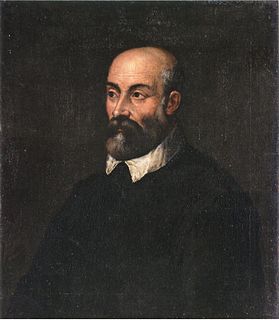
Andrea Palladio was an Italian Renaissance architect active in the Venetian Republic. Palladio, influenced by Roman and Greek architecture, primarily Vitruvius, is widely considered to be one of the most influential individuals in the history of architecture. While he designed churches and palaces, he was best known for country houses and villas. His teachings, summarized in the architectural treatise, The Four Books of Architecture, gained him wide recognition.

The Grand Canal is a channel in Venice, Italy. It forms one of the major water-traffic corridors in the city.

The piano nobile is the principal floor of a palazzo. This floor contains the main reception and bedrooms of the house.
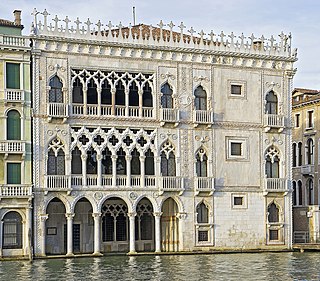
The Ca' d'Oro or Palazzo Santa Sofia is a palace on the Grand Canal in Venice, northern Italy. One of the older palaces in the city, its name means "golden house" due to the gilt and polychrome external decorations which once adorned its walls. Since 1927, it has been used as a museum, as the Galleria Giorgio Franchetti.

Ca' Foscari, the palace of the Foscari family, is a Gothic building on the waterfront of the Grand Canal in the Dorsoduro sestiere of Venice, Italy.

Ca' Rezzonico is a palazzo on the Grand Canal in the Dorsoduro sestiere of Venice, Italy. It is a particularly notable example of the 18th century Venetian baroque and rococo architecture and interior decoration, and displays paintings by the leading Venetian painters of the period, including Francesco Guardi and Giambattista Tiepolo. It is a public museum dedicated to 18th-century Venice and one of the 11 venues managed by the Fondazione Musei Civici di Venezia.

Pauly & C. - Compagnia Venezia Murano is one of the most ancient glass factory of Murano: it was founded more than 150 years ago. This company produces glass art, most notably Roman murrine, mosaics and chandeliers.
The architecture of Rome over the centuries has greatly developed from Ancient Roman architecture to Italian modern and contemporary architecture. Rome was once the world's main epicentres of Classical architecture, developing new forms such as the arch, the dome and the vault. The Romanesque style in the 11th, 12th and 13th centuries was also widely used in Roman architecture, and later the city became one of the main centres of Renaissance and Baroque architecture. Rome's cityscape is also widely Neoclassical and Fascist in style.

Palazzo Aragona Gonzaga is a 16th-century palace in Rome, Italy; it was once the residence of Cardinal Scipione Gonzaga. Today, its late Renaissance street facade bears plaques commemorating two of its residents, Saint Aloysius Gonzaga and the poet Torquato Tasso.

The Palazzo Barbarigo Minotto is a 15th-century palace on the Grand Canal in Venice, northern Italy, next to the much larger Palazzo Corner. Built in the Venetian Gothic style, it was originally two palaces, Palazzo Barbarigo and Palazzo Minotto, later joined together. The Barbarigo palace was owned by the Barbarigo family for several centuries and was the birthplace of Gregorio Barbarigo, who once refused the Papal Crown. It was later owned by the Minotto and Martinengo families.

Palazzo Pisani Moretta is a palace situated along the Grand Canal in Venice, Italy between Palazzo Tiepolo and Palazzo Barbarigo della Terrazza.
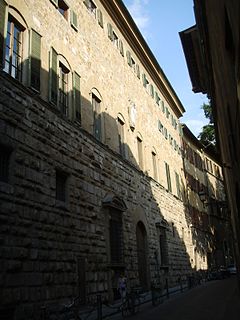
Palazzo Capponi alle Rovinate is a late-Gothic and early Renaissance-style residential palace located on Via de' Bardi in Florence, region of Tuscany, Italy. There are apparently three other palaces once associated with the Capponi family:

The Palazzo Clary is a Late Renaissance Venetian palace facing the Giudecca Canal alongside the fondamenta Zattere by the ponte longo in Venice's Dorsoduro. It was originally built in the 17th century for a Venetian noble family. In the early 19th century, the palazzo is known as Palazzo Clary, named after it was bought by the prince Clary-Aldringen. The neighboring building is Palazzo Giustinian Recanati.

The Palazzo or Ca' Cappello Layard is a palace situated in the sestiere of San Polo of Venice, Italy, overlooking the Grand Canal at the confluence between this and the smaller Rio di San Polo and Rio delle Erbe. On the Grand canal, it is located between Palazzo Barbarigo della Terrazza and Palazzo Grimani Marcello. It is particularly noteworthy for having been the residence of Austen Henry Layard, discoverer of Nineveh.

The Palazzo Piccolomini, also known as the Palazzo Todeschini Piccolomini is a Renaissance-style palace in the city of Siena, region of Tuscany, Italy. It is located on the Banchi di Sotto, at the corner with Via Rinaldini; uphill and west of the church of San Martino, the Loggia del Papa, and the Palazzo delle Papesse, which also built by a Piccolomini family member.
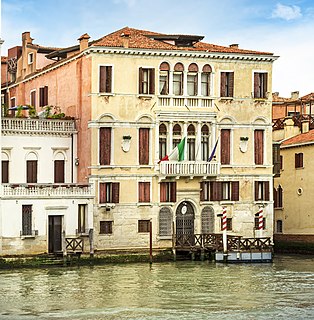
The Palazzo Gussoni Grimani Della Vida, also called Grimani a San Fosca is a Renaissance-style palace on the Grand Canal, located between the Palazetto Barbarigo and the Rio di Noale, in the sestiere of Cannaregio, in Venice, Italy.
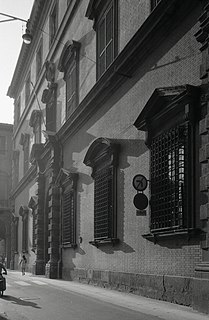
The Palazzo Caprara, also called Palazzo Galliera is a Renaissance-style urban palace located on Via IV Novembre #22 in central Bologna, region of Emilia-Romagna, Italy.
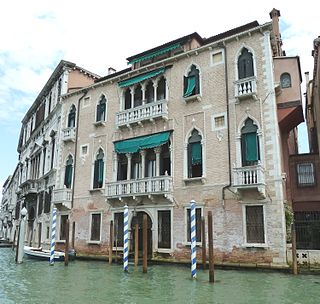
Palazzo Erizzo Nani Mocenigo is a palace in Venice located in the San Marco district and overlooking the Grand Canal between Palazzo Da Lezze and Palazzo Contarini delle Figure.

The Palazzo della Provincia e della Prefettura is a public palace of Perugia built over the ruin of the Rocca Paolina.


















